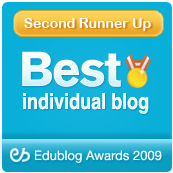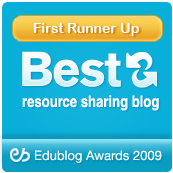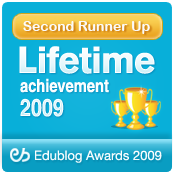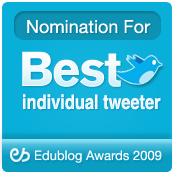Oct 04 2009
The Best Web 2.0 Applications For Education — 2009
The two most popular posts that I’ve ever written in this blog have been The Best Web 2.0 Applications For Education — 2007 and The Best Web 2.0 Applications For Education — 2008, and now it’s time for this year’s edition.
The poll for this list — The Best Web 2.0 Applications For Education — 2009 — is located below this post, and closes on February 1, 2010. Please vote for no more than ten of the thirty-two sites listed. Please note that I’ll be listing these sites in my post from my pick from number thirty-two and ending at first place, but the poll is listed in the opposite order.
In order to make this list, a site had to be:
* accessible to English Language Learners and non-tech savvy users.
* free-of-charge.
* appropriate for classroom use.
* completely browser-based with no download required.
It’s possible that a few of these sites began in 2008, but, if so, I’m including them in this list because they were “new to me” in 2009.
You might also be interested in exploring the 300 other “The Best…” lists that I’ve posted over the past two years.
Here are my choices for The Best Web 2.0 Applications For Education — 2009:
Number thirty-two: Toobla is a brand new visual bookmarking site. I would actually rank it higher on this list, but didn’t learn about it until after I had completed this post and didn’t have it in me to reorder everything. It lets you very easily display thumbnail images of websites, photos, and videos. You can read in The Best Social Bookmarking Applications For English Language Learners & Other Students how I use these kinds of sites to promote higher-order thinking in students.
Number thirty-one: BookRix is a new site that lets you very easily upload a document which is then turned into an embeddable virtual book. It’s easy-to-use, and the final product has a neat interface that I think students would like. The site also seems to have a fairly strict code on content suitability.
Number thirty: Strutta is a really neat site that lets you very easily create contests (for free) where people can enter videos, images, or text. Multiple winners can be judged by popular vote or by the contest creators. It has a ton of other “bells & whistles,” too. Teachers can set-up these contests or, even better, students can create their own. With a little direction, English Language Learner students should be able to navigate the site. I think there are a ton of ways this can be used in fun and engaging ways for language development.
Number twenty-nine: Embedr lets you easily make a playlist of videos from across the web, and then lets you embed them all with one embed code. This could come in handy if you want your students to watch a series of videos you embed into your own site. Embedr certainly is compatable with a ton of video-hosting sites, including TeacherTube and Edublogs TV .
Number twenty-eight: WeToku is a neat online app that lets you interview someone via webcam, and records it for later viewing. You can read more about it at Nik Peachey’s blog. There are lot of things that can be done with this kind of tool, but using webcams is problematic at many schools.
Number twenty-seven: Embedit.in lets you to upload any file or url address, and then create an embed code for it so it can be embedded in a blog or website. It’s made by the same company that created Backboard, which I’m very impressed with. Webware wrote a post about it that’s worth reading. Embedit.in is very helpful. Students can embed many of their Web 2.0 projects that just allow them to create links right now, such as the ones on my Examples of Student Work page. Instead, they can upload the url addresses of their creations to, for example, websites they’ve made.
Number twenty-six: I’ve added Ediscio to my very tiny The Best Tools To Make Online Flashcards list. You can create, and use, flashcards very quickly and easily, and grab images and videos off the Web to insert them in the virtual cards.
Number twenty-five: Quizlet is another new site on The Best Tools To Make Online Flashcards. In addition to letting you create and study flashcards, it also lets you study the words in “game” forms. Plus, it allows voice recording for some features.
Number twenty-four: Hipero bills itself as “The easiest Free Website Builder ever!” I don’t know if that’s accurate, but it is, indeed, pretty easy to use. I’ve added it it to The Best Ways For Students Or Teachers To Create A Website.
Number twenty-three: Doodle has been added to The Best Sites For Creating Online Polls & Surveys. Registration isn’t required, and it’s extremely easy to create a poll that can be embedded in a blog or website or be accessed via its url address. Participants can leave comments, too. It appears to have been set-up primarily to organize group events, but it can be used as a poll for just about anything.
Number twenty-two: Yarp is a new web tool that very,very easily lets you create a simple online invitation or survey. I’m particularly interested in the survey aspect, and I’m adding it to The Best Sites For Creating Online Polls & Surveys. It has a lot of benefits: no registration is required; you can quickly type a question in and choosed various responses (a or b; true or false, yes or no); and those who respond can also write their own comments. This is a stand-out application for English Language Learners who want to use a simple survey for an in-class project or, even better, with sister classes in other places. It provides wonderful and accessible opportunities for reading and writing.
Number twenty-one:Flash Meeting looks like a very impressive free application for video conferencing. It’s designed specifically for school use, and you can participate even if you don’t have a microphone (you can text) or a webcam. I’m adding it to The Best Online Tools For Real-Time Collaboration.
Number twenty: PodOmatic is an extraordinarily easy way to create a podcast. Sign-up and your class has your own channel — all you need is a computer microphone. I’m adding it to The Best Sites To Practice Speaking English. I’m also adding it to The Best Places Where Students Can Create Online Learning/Teaching Objects For An “Authentic Audience”.
Number nineteen: MapBuzz is also a new addition to The Best Map-Making Sites On The Web. As I describe on that list, using an easy mapmaking site like MapBuzz can be an excellent learning activity for English Language Learners and all students. “Markers” or “push-pins” can indicate with text and images places visited and routes taken on a field trip; battles fought in a war; key milestones in the life of a student or a famous figure; highlighting key natural disasters around the world — and these are just a few examples. MapBuzz lets your draw lines, insert images, write text — all in a very accessible way.
Number eighteen: I’ve known about DoInk for awhile, but when I first visited the site it seemed a little too complicated to me for creating an online animation. But I recently visited it again and liked what I saw. I would say it’s slightly more complicated than some of the other animation tools I’ve listed on The Best Ways For Students To Create Online Animations and The Best New Sites Students Should Use With Supervision, but English Language Learners should be able to make simple animations pretty easily. I especially like what sounds like a strict and pro-active policy at ensure classroom appropriate content on the site.
Number seventeen: PinDax is a new web tool that lets you “pin” virtual “Post It” notes on a virtual bulletin board. It’s very, very similar to a tool I like a lot called Wallwisher. It has a lot more “bells and whistles” than Wallwisher. That additional complexity (and I have to admit, it doesn’t seem that much more complex — it just seems to have a lot more options) doesn’t necessarily make it more attractive for classroom use.
Number sixteen: Chirbit is also the newest addition to The Best Sites To Practice Speaking English. After registering (which is very easy — I love sites that don’t require an email activation), you can very easily make a recording or use a text-to-speech feature to create audio. You’re then given a unique url address for the recording. It’s as simple as that. It has other capabilities, too, including responding to the audio message.
Number fifteen: Rooh It! is a tool to annotate webpages. Since the Make Use of blog has written a good post describing it, I’m going to encourage you to read their explanation. I’d like to highlight a couple of great features, though. One, you don’t have to register for it. And, two, all you have to do is put “roohit.com/” before any web URL address and you can start highlighting and leaving notes about it. The only negative I see is that it looks a little “busy” — English Language Learners could be a bit confused by all the initial options and text. But a short teacher explanation should take care of that.
Number fourteen: Grapevine is an audio “chatboard” that I’m adding to The Best Sites To Practice Speaking English. t’s super-simple to set-up a private forum where students can listen and respond to others and don’t have to be online at the same time. English Language Learners can communicate with other classes around the world, like in our International Sister Classes Project or just be given a simple speaking assignment to complete.
Number thirteen: Gizmoz lets you pick from a variety of images, then choose a background, and then quickly speak a message or, using the text-to-speech feature, type one. Then, after signing-in (registering or signing-in just takes seconds) you can either email the link or post it yourself on a blog or website. As an opportunity for speaking practice, it doesn’t get much easier, which is why I’m adding it to The Best Sites To Practice Speaking English. The only tricky part is that you can access messages other users have created, too. I didn’t see anything that was inappropriate for the classroom, but I just don’t know how much that’s monitored.
Number twelve: Google Voice is Google’s new phone tool. In terms of teaching, I could see it as an easy way for English Language Learners, particularly those with no Internet access, to practice speaking “homework.” They can call my Google Voice number, leave a message, and I can then access both their audio and an automatically generated written transcript of what they said. I can then easily embed both on a classroom blog. I’m also adding it to The Best Sites To Practice Speaking English.
Number eleven: Fur.ly is a new tool that lets you combine multiple links into one. It’s a little different from others I’ve posted about — they show you visual snapshots of each site that you can then click on one at a time. Fur.ly, on the other hand, shows you the first link in the collection and you can then click on arrows to go review each one. I’m adding it to both The Best Places To Create (And Find) Internet Scavenger Hunts & Webquests and The Best Ways To Shorten URL Addresses.
Number ten: Sketchcast was on The Best Web 2.0 Applications For Education — 2007 list, and then was off-line for a very long time, is now back and operating. It was gone long enough to now qualify for this year’s list. For those of you who don’t remember what it is, It’s like “drawing” a video (you can also type text) that can be replayed. In Sketchcast you can also easily provide audio narration to your sketch. Your completed work has a unique url, and visitors can leave comments. It works for English Language Learners on a number of levels.
Number nine: Note Pub is a great way for students to share their work on the Web. before, but ignored it because it required downloading an application to upload photos. But a post in Technology Tidbits prompted me to take another look. It’s extremely easy to register and, it’s very easy to write text. Plus, like Posterous, you can just copy and past images off the web. But it seems even easier than Posterous. Of course, it won’t look as pretty and it’s not really in a blog format. But I think if you’re working with students who have very little technology experience, and you just want them to have an easy place where they can paste their work (and where other students can view it, too, after the links to all student sites are posted on a teacher page), Note Pub might just be the web application to use. Obviously, they won’t be able to post comments, but that can all happen orally.
Number eight: Babelwith.me is the newest addition to both The Best Online Tools For Real-Time Collaboration and The Best Online Tools For Collaboration — NOT In Real Time. No registration is required, and it takes a few seconds to set-up a private chatroom. Of course, a number of other tools on those lists do the that same thing. However, Babelwith.me lets you do it and automatically translates what you’re saying in the recipients language and in the language you’ve written. This last feature could be very helpful with English Language Learners (or any other students) communicating with sister classes in other countries. Another great capability is that the chatrooms themselves appear to stay active indefinitely, so users can come back to them whenever they want to continue the conversation.
Number seven: MapTrot is the newest addition to The Best Map-Making Sites On The Web. No registration is required and it’s super-easy to use. You can write descriptions of the points you place on the map, and you can link to a Google search of images for that place, but you can’t choose a specific photo. (There seems to be a problem with this site — I don’t know if it’s temporary or not).
Number six: Blerp lets you annotate webpages and, I think, might be the best tool of its kind out there. Once you register (which is extraordinarily easy and doesn’t require activation by email), you type in a webpage address, click on “post” and you can type on a virtual post-it note and place it anywhere on the text of the page and you are then given the page’s url with the notes. It’s extremely user-friendly.
But that’s not all.
It also allows you to see what other readers of the same page have written. All those virtual post-it notes are listed on the side of the page. All you have to do is click on a note and it magically appears at the location on the page where it was placed. I believe a lot of the things many web tools allow you to do are neat, but don’t necessarily provide much “value-added” benefit to doing the same task using non-tech tools. Even the other tools on the “website annotating” best list only let you do the exact same thing you can do with hard copy.
With Blerp, however, after students have completed demonstrating their reading strategies, they can then see what everybody else has written, too. Now, that’s what I’m talking about in terms of a way technology can enhance learning.
I think the ability to annotate webpages — the equivalent of making notes on a written text — is absolutely critical for students to develop their reading skills. Using “post-it” notes on text to demonstrate the use of reading strategies is a key teaching and learning approach I use in the classroom. I am always searching for web tools that will allow students to do the same on Internet pages, which is why I created the The Best Applications For Annotating Websites and, obviously, added Blerp to the list.
Number five: I’ve posted in the past about how the ability to make easy screencasts — with audio– could be an excellent learning opportunity for English Language Learners (you might want to take a look at that post). A screencasting tool called Screentoaster couldn’t be more simple to use, and they’ve just added both the ability to record audio and add subtitles. All you do after you log-in is click on a button, open up the window on your screen that you want to record, and it starts recording your screen. After that’s been recorded, you can provide audio or subtitles. And it’s free. I’ve also placed it on The Best Sites To Practice Speaking English.
Number four: ProProfs, the exceptional multi-tool site that is already on The Best Ways To Create Online Tests and The Best Tools To Make Online Flashcards lists, now may be the number one tool on The Best Sites For Creating Online Polls & Surveys list. Their new poll-making feature has just about everything I’m looking for in a tool to create polls — very accessible, you can easily add images or videos, you can include links, they’re embeddable, there are no limits in the number of responses, you can restrict voting and….it’s free.
Number three: Wallwisher lets you, with very, very minimal registration, create a “wall” where you can place virtual sticky-notes. You can allow others to also place notes on the board, or keep it so that only you can do so (which is what I would recommend for students). The sticky-notes can include images you grab off the web, videos, or websites, and you can add text to them (you can also just include text without adding anything else). Each sticky has a 160 character limit for text.
Wallwisher appears to me to be one of the most useful Web 2.0 sites I’ve found in awhile. It can be a great place for students to use higher-order thinking by creating categories of images (and descriptions) or short texts they copy and paste (or write themselves). It can also be used as a site for social bookmarking of websites if you just right-click the website you put inside the sticky-note and then click on “open in a new window.”
I’ve explained in The Best Social Bookmarking Applications For English Language Learners & Other Students more details on how a site like Wallwisher can be used by English Language Learners for categorization and website bookmarking applications, and I’d encourage you to take a look. The other sites listed there can be used for similar purposes, but Wallwisher appears to be the easiest and most user friendly of the bunch.
Number two: PhotoPeach is an excellent online slideshow creator that is very easy to use. You can upload your own images as well as grab them off the Web. Plus, you can also now create quizzes within your slideshow. I’ve also added it to The Best Ways To Create Online Slideshows.
Number one: File2.ws lets you, without registering, quickly upload any document and turn it into a webpage. This is an extraordinary tool. You can see examples of how my students used it to create multilingual materials on swine-flu prevention. Students can create anything, for example, using Microsoft Word, and immediately turn it into a webpage. This is an extraordinary way for people who are not familiar with creating online content to use a program that they’re familiar with — like Word — and develop something very useful that can be shared with everybody.
Don’t forget to vote in the poll that appears after this post.
As always, feedback is welcome.
29 responses so far
Create a free edublog to get your own comment avatar (and more!)













Fabulously useful and inspirational list.
Many thanks
Clare
[Reply]
Wow, what a ton of cool sites to check out. When do you sleep?
[Reply]
[...] The Best Web 2.0 Applications For Education 2009 Larry Ferlaz [...]
Nice list. I recommend http://www.studyblue.com. They are doing some really nice things with that site.
[Reply]
[...] The Best Web 2.0 Applications For Education – 2009 | Larry Ferlazzo’s Websites of the Da… [...]
Thanks for bringing these sites together for us. Ditto Jim–when do you sleep?
[Reply]
[...] The Best Web 2.0 Applications For Education [...]
[...] “Toobla – A great way to discover visual (video) content” – ReadWriteWeb “The Best Web 2.0 Applications for Education – 2009” – Larry Ferlazzo. “10 Amazing Tools for Sharing Visual Inspiration through [...]
Please have a look at the Flemish (Beglian) portal for and by teachers. About 46000 members (teachers) are sharing over 10000 good practices …
also in English: http://www.klascement.net/?set_language=4
[Reply]
This seems like a very well researched list. Some of the sites listed, like NotePub, are almost unknown and underhyped yet really worth a try.
[Reply]
[...] Larry Ferzallo has listed 32 best Web 2.0 applications for teachers. Click here. [...]
[...] The Best Web 2.0 Applications For Education — 2009 | Larry Ferlazzo’s Websites of the Day… [...]
[...] October 13, 2009 at 2:27 am (Uncategorized) via larryferlazzo.edublogs.org [...]
[...] The Best Web 2.0 Applications For Education — 2009, and vote in the poll. [...]
[...] Complete list available here. [...]
LArry,
THakns for the links. Lots of good stuff. SKetchcast seems to be playing up–wouldn’t let me use audio or publish, but this is a great tool for online teaching / learning.
[Reply]
Thanks again for great information! I love lists like these because it makes it easy to find your favorites or to send suggestions to other people. I know many of these apps, however, I see a few new ones. I can’t wait to go play and see how I can use these in our homeschooling. You’re awesome!
[Reply]
As always just an amazing collection of the best of the best. Thanks!
[Reply]
Thanks for the list! I’d like to also humbly mention my own site, “EDU 2.0 for School”, which is a completely free, web-hosted learning management system that is similar in features to Moodle and Blackboard but is MUCH easy to use. Launched in 2006, it has over 110,000 users and is doubling in size every 6 months. Its URL is http://www.edu20.org.
Cheers,
Graham Glass
Founder, EDU 2.0 for School
[Reply]
Would say: CoboCards (http://www.cobocards.com)
Maybe next time
[Reply]
I just shared your post with the National Writing Project technology liaisons. Thanks Larry, for all that you do.
Kevin
[Reply]
[...] was inspired to write this post by Larry Ferlazzo’s post, although his list is a bit longer than mine! I went into Glogster (which I am still figuring out [...]
Larry
You inspired me:
http://dogtrax.edu.glogster.com/cooltools2009/
and I set up a Wallwisher site, if anyone wants a space to share out a tool they liked in 2009.
http://www.wallwisher.com/wall/dogtraxtools2009
Kevin
[Reply]
As the year ends, I’m catching up on my tech skills. This comprehensive list has given me a solid, detailed homework assignment.
Thank you.
[Reply]
Best topics in education_technology for 2009-11-28…
Best topics in education_technology for 2009-11-28…
[...] Ferlazzo – an intrepid and generous blogger who writes the wonderful Larry Ferlazzo’s Websites of the Day has put together a list of the best web 2.0 Applications and invites us to vote …. [...]
[...] Larry Ferlazzo’s Best 2.0 Tools for Education 2009 [...]
[...] The Best Web 2.0 Applications For Education — 2009 [...]
[...] The Best Web 2.0 Applications For Education — 2009 [...]